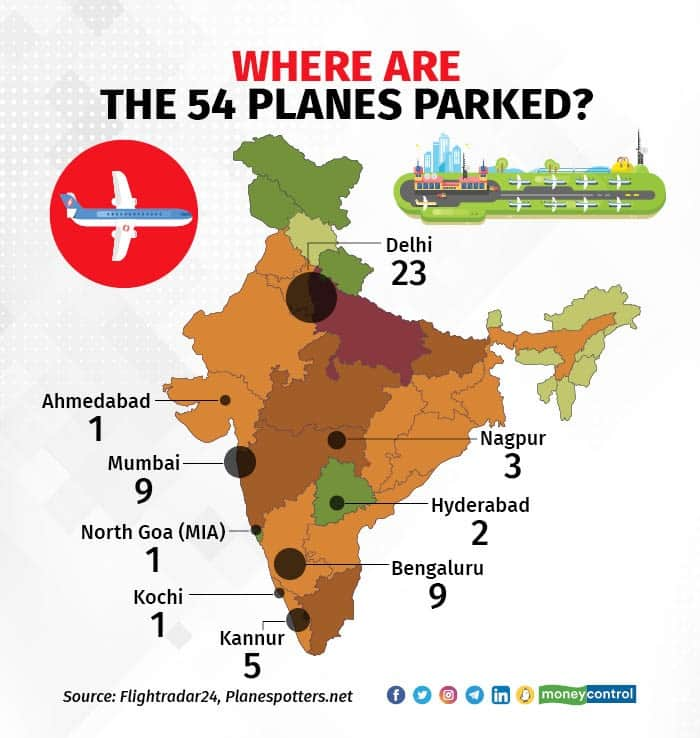



As the flight from Abu Dhabi landed in New Delhi on May 3 morning, Go First had shut operations. The counters across its 25-plus stations were deserted.
Both the speed and the stealth of the developments that led to this situation were surprising. In the case of Jet Airways in 2019 or Kingfisher Airlines in 2012, the decline was gradual and predictable, with lessors taking away planes, stations being closed, flights being reduced and salaries being delayed before things came to the fore and the carriers had to be shut down.
Cut to 2023. Everyone knew about the challenges and problems at Go First, which stemmed primarily from engine issues. The Pratt & Whitney engines spent less time on the wings than promised and replacements didn’t come in at the desired rate, leading to the grounding of planes for both Go First and IndiGo.
The impact on IndiGo was mitigated as the airline re-inducted some of the planes and also because the majority of its A320neo family of aircraft is now powered by CFM engines instead of those from Pratt & Whitney.
Last month, four Go First planes were returned to lessors, following the departure of another two, even as new aircraft ready at the Airbus plant in Europe were sent into storage.
Now that the airline has admitted itself to insolvency proceedings and is awaiting the court’s ruling on the next steps, its 54 planes are parked in nine airports in the country.
Where are the planes?Data accessed from flight tracking websites FlightRadar24 and Planespotters show that the airline has parked 23 of its aircraft in New Delhi, which is about 43 percent of its fleet. The recently commissioned apron at Delhi, which was to help with additional movements, has become a parking lot of sorts for the grounded aircraft of IndiGo and Go First. The grounding is so old that they are visible on Google Maps satellite imagery, which isn't updated regularly.
Bengaluru and Mumbai have nine each, while Kannur, which the airline had made an important base to launch its Middle Eastern operations, has five. Nagpur has three while Hyderabad has two. Ahmedabad, Kochi, and Manohar International Airport in North Goa have one each.
Even as the airline awaits directions on the next steps, it will have to spend money to keep the aircraft in good condition, as mandated by the aircraft manufacturer. Long-term parking involves ensuring that rodents are kept out of critical areas to avoid damage and allow ease in reactivation.
Frequent fliers at Delhi and Bengaluru would have noticed how critical areas of the aircraft have been strapped.

Most airports have limited parking areas. The larger ones in Delhi, Bengaluru and Mumbai have been sought by airlines for a long time to add capacity.
Airports are designed to utilise infrastructure such as aprons, bays, and check-in counters repeatedly. Profitability depends on quick turnarounds that make space available for the next aircraft movement.
When the bays are occupied by long-term parking of aircraft, potential revenue is impacted. This also impacts passengers because additional movements cannot be allotted to other airlines willing to increase capacity.
The airports at Delhi, Chennai and Kolkata still have mothballed aircraft from the past. Since the airports have not been able to recover the dues, they have pushed the planes to places out of operational areas, but it has taken years to do this and sometimes after getting orders from courts. The same cannot be done immediately for the aircraft of Go First.
With every passing day, the parking bill of these planes goes up and there is no guarantee that the airline, now or after the bankruptcy court order, would be in a position to pay.
What next?Lessors will look for ways to repossess their aircraft at the earliest. Once the aircraft is gone, there is no way the airline can potentially earn revenue.
At the same time, lessors would be constrained from taking away all the planes since the airline has said that almost 50 percent of its fleet is grounded due to the lack of engines. In such a situation, the lessor will have to spend money to get engines for the planes before flying them out, which gets us back to the point where it all began – the lack of engines.
There are more questions than answers for now and time will tell how things pan out. Until then, the aircraft at nine airports will be a sad reminder of how brutal Indian aviation is and a reminder to airport operators to find ways to avoid getting into this situation again.
Discover the latest Business News, Sensex, and Nifty updates. Obtain Personal Finance insights, tax queries, and expert opinions on Moneycontrol or download the Moneycontrol App to stay updated!
Find the best of Al News in one place, specially curated for you every weekend.
Stay on top of the latest tech trends and biggest startup news.